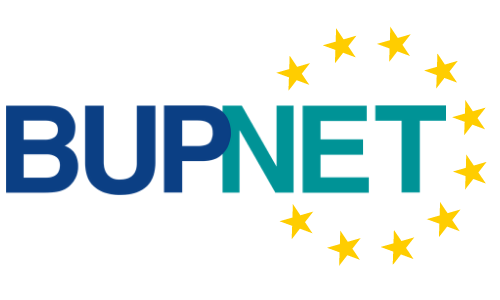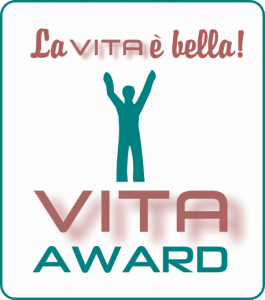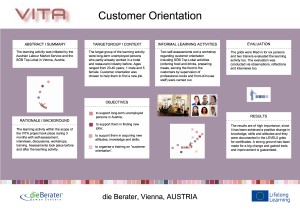 VITA intends to provide a system to validate personal and social competences by making use of the LEVEL5 system which is specifically designed to assess and visualise personal, social and organisational competence developments in rather non- and informal learning settings. In the VITA pilots LEVEL5 was tested in a huge variety of learning contexts.
VITA intends to provide a system to validate personal and social competences by making use of the LEVEL5 system which is specifically designed to assess and visualise personal, social and organisational competence developments in rather non- and informal learning settings. In the VITA pilots LEVEL5 was tested in a huge variety of learning contexts.
Relevance of personal, social, and organisational competences
It appears that there is an ever-increasing interest concerning personal, social, and organisational competences (SPOC). Employers are very aware of the importance that employees’ SPOC have for their carrying out of their jobs, and they see SPOC as an increasingly important area. These are the very clear indications that have come out of a survey carried out by partners in the VITA project. In addition, SPOC are also seeing a growing interest in the world of education.
This emphasises the relevance of not only developing SPOC, but also systematically following its development in various types of learning and training programmes. The VITA partners have worked with the development of SPOC in eight very different learning contexts and measured the SPOC development of the individual participant. This has been done through the use of LEVEL5, a method that allows for the description of competences across three dimensions: cognitive, activity and affective dimensions. LEVEL5 can also be used in the formulation of what makes up a given competence, just as it can be used as a measure of the learner’s competence development.
The VITA pilots
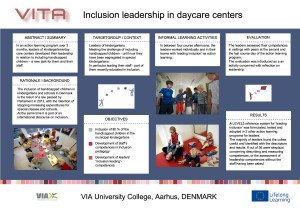 In the VITA project, LEVEL5 has been applied in very different learning contexts ranging from 11th-12th-grade volunteer students in a “Club GREEN” (Turkey) to students on an obligatory practice placement during their BA education as counsellors (Lithuania) and work-place-related courses for supermarket employees (Germany) and managers in day-care centres (Denmark). Furthermore, two very different job training programmes for long-term unemployed people were part of the project’s piloting activities: job training for hotel and restaurant e
In the VITA project, LEVEL5 has been applied in very different learning contexts ranging from 11th-12th-grade volunteer students in a “Club GREEN” (Turkey) to students on an obligatory practice placement during their BA education as counsellors (Lithuania) and work-place-related courses for supermarket employees (Germany) and managers in day-care centres (Denmark). Furthermore, two very different job training programmes for long-term unemployed people were part of the project’s piloting activities: job training for hotel and restaurant e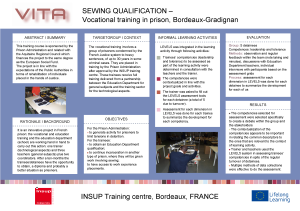 mployees (Austria) and a men’s group from a deprived local area, where networking activities were arranged. The final two projects were done in relation to a sewing course for a group of prisoners (France) and in a project aiming at validating the competences of adult educators (Greece).
mployees (Austria) and a men’s group from a deprived local area, where networking activities were arranged. The final two projects were done in relation to a sewing course for a group of prisoners (France) and in a project aiming at validating the competences of adult educators (Greece).
Various learning contexts
As it appears from this, there is great variety when it comes to both target groups and institutional context and thus also the intended aims and learning outcomes of the learning activities as well as participant motives.
For instance, the aim of the French prisoners was to qualify for work in the prison and thus improve their own conditions and – for some – maybe for early release. For the long-term unemployed in Austria and the Irish men’s group, the aim was to gain a foothold on the labour market, whereas the students in Turkey were motivated by the possibility to work closely with their teachers and be able to function as tutors for their peers and contribute to e greener environment.
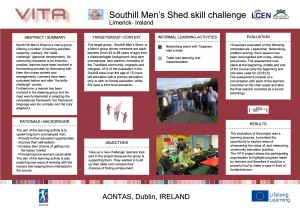 Even though the learning contexts were so diverse, several concrete competences recur across the projects: customer orientation, communication, problem solving, networking, leadership etc. The use of LEVEL5 did have an effect on all the learning activities no matter whether LEVEL5 had been taken into consideration already in the planning of the activity or not included until later. As expected, the reports on the pilots generally show that participants become more conscious and aware of their own competences.
Even though the learning contexts were so diverse, several concrete competences recur across the projects: customer orientation, communication, problem solving, networking, leadership etc. The use of LEVEL5 did have an effect on all the learning activities no matter whether LEVEL5 had been taken into consideration already in the planning of the activity or not included until later. As expected, the reports on the pilots generally show that participants become more conscious and aware of their own competences.
Assessment methods and participant response to the assessment
In the choice of assessment method in the pilots, the different contexts for learning as well as participants’ starting points and competences were very much taken into consideration. No matter which methods have been used, the results of the pilots clearly show that participants are affected by the assessment. When participants are assessed by others, they are very much focused on this evaluation, and both went being validated by others and by them-selves, this spurs reflection. This is probably also true of the number of other assessment tools; but special to the pilot project at hand is that LEVEL5 has been used actively to sup-port learning processes and that the detailed and fine grained assessment has been effective in helping learners to be aware of, reflect on, and have proof of competences otherwise only assessable with difficulty.
Further impact
Finally, individual pilot partners have seen the effects that reach above and beyond participants’ expected learning. The use of LEVEL5 initiated reflections among the teachers, not only on SPOC but also on content, methods and differentiation. Furthermore this kind of as-sessment of SPOC can show decision-makers that participants actually do develop their SPOC through the learning activities.
